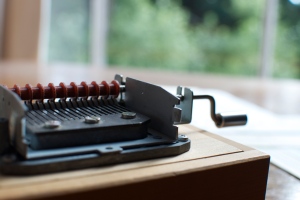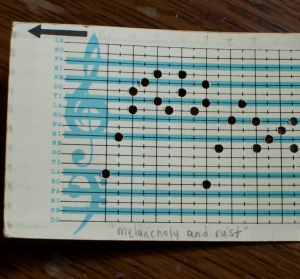sevens/glass island reel
Sevens/Glass Island Reel:
(two flutes, piano accordion, Garageband loops)
Sevens. I learned this Liz Carroll original from her 2000 album Lost In the Loop. At first glance this tune does not seem flute friendly because too much of the drone melody sits on the lowest fiddle string (out of flute range). But I found most of the low drones were still convincing when brought up an octave.
Glass Island. Ethan Hazzard-Watkins wrote this contemporary contra dance tune in 1997. He’s writes that it was “never intended to be an Irish session tune.” But someone else captured a session recording and started emailing it around. I ran across that recording when local fiddler Joel Mesnikoff sent it to me in October this year.
palm sunday
Palm Sunday:
(flute, accordion, Garageband loops, palm banging on Ikea bookshelf)
I’ve been playing games with meter and rhythmic emphasis. Palm Sunday is a traditional double jig in 6/8, and here I follow it with a “reel-ified” version of itself. At the metric transition (1:04) I keep the eighth note beat the same but force the tune into 3/4. One musician friend calls it “a heinous and impossibly fast death waltz,” but I think of it more as a reel with 6 subdivisions per strong beat (as opposed to the usual 4 subdivisions per strong beat).
Parts of the original 6/8 tune resemble a slide instead of a jig, so it already has some atypical phrase shaping that makes the tune feel a bit “off,” and I distort those phrases even more with the additional melody notes in my 3/4 version. Some traditional music practitioners find the 3/4 adaptation to be quite disturbing – they feel it goes too far beyond the form and thus isn’t stable enough. I don’t know what I think yet.
melancholy and rust (a composition for punch hole music box)
My long lost friend Hans Fex generously lent me this twinkly music box. Use a special hole puncher to punch out individual notes on a strip of paper, then run the paper through the machine to hear the results. The templates come printed with a grid so you can hit each note dead center.
This composition for punch hole music box, Melancholy and Rust, is more than just a lovely tune. Its melody and accompaniment are designed so that the piece can be run through the machine right side up, upside down, and backward-upside-down. For you music geeks out there, that’s a shout out to the principles of 12-tone composition, here using prime, inversion, and retrograde inversion techniques. Only instead of flipping staves upside down and backward, we are flipping a piece of paper. This particular music box has a diatonic 1 octave+6th range (C to A), so if you use the full range of notes, A minor will invert to C major, and vice versa.
Oh, toss all that theoretical nonsense aside! Begone academia! The real delights here are the twinkly tone, the creaking and rattling of the mechanism, the astonishing power of the miniature resonating box. And what about the delight of (mis)punching holes and surprising yourself with the results? True, it tries my patience to meticulously scotch tape closed any mistaken punches, but it’s usually best to just integrate them the final product. Best of all, musicians and non-musicians alike can punch-compose, perhaps using musical knowledge, visual patterns, random bites, blind inspiration, or other aesthetics.
Now, Melancholy and Rust, played in three different orientations.
Oh, twinkly music box. <sigh>



